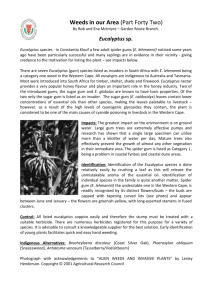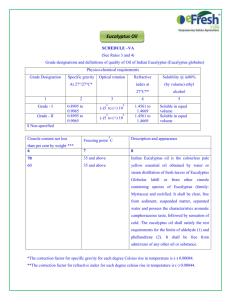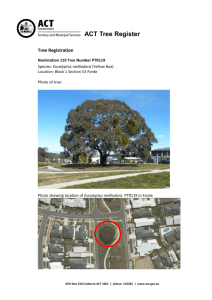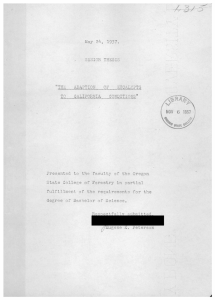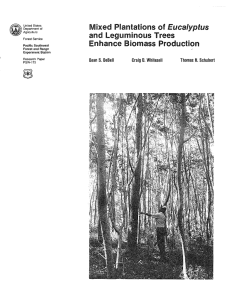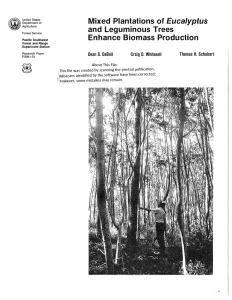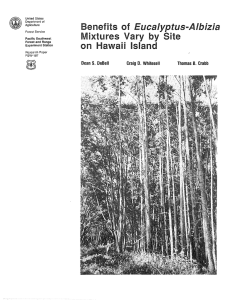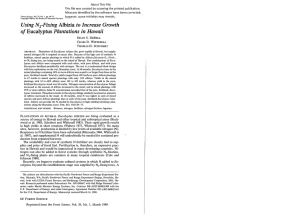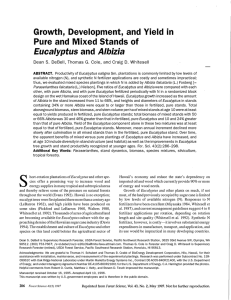Eucalyptus globulus 1
advertisement
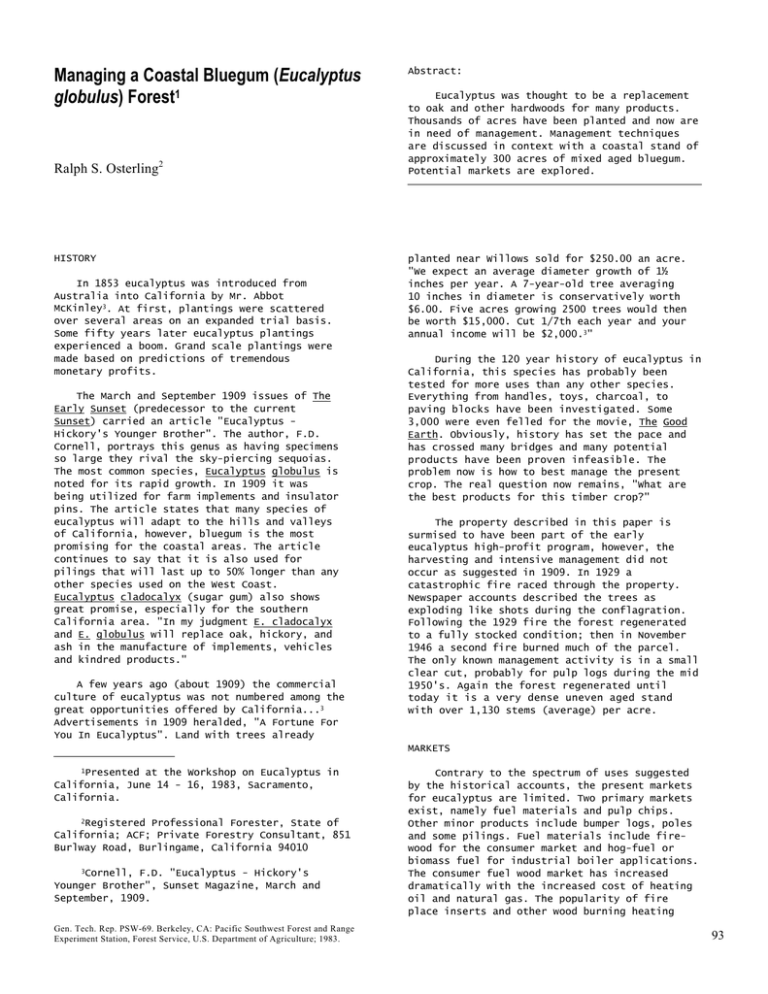
Managing a Coastal Bluegum (Eucalyptus globulus) Forest1 Ralph S. Osterling2 HISTORY In 1853 eucalyptus was introduced from Australia into California by Mr. Abbot McKinley3. At first, plantings were scattered over several areas on an expanded trial basis. Some fifty years later eucalyptus plantings experienced a boom. Grand scale plantings were made based on predictions of tremendous monetary profits. The March and September 1909 issues of The Early Sunset (predecessor to the current Sunset) carried an article "Eucalyptus Hickory's Younger Brother". The author, F.D. Cornell, portrays this genus as having specimens so large they rival the sky-piercing sequoias. The most common species, Eucalyptus globulus is noted for its rapid growth. In 1909 it was being utilized for farm implements and insulator pins. The article states that many species of eucalyptus will adapt to the hills and valleys of California, however, bluegum is the most promising for the coastal areas. The article continues to say that it is also used for pilings that will last up to 50% longer than any other species used on the West Coast. Eucalyptus cladocalyx (sugar gum) also shows great promise, especially for the southern California area. "In my judgment E. cladocalyx and E. globulus will replace oak, hickory, and ash in the manufacture of implements, vehicles and kindred products." A few years ago (about 1909) the commercial culture of eucalyptus was not numbered among the great opportunities offered by California...3 Advertisements in 1909 heralded, "A Fortune For You In Eucalyptus". Land with trees already Abstract: Eucalyptus was thought to be a replacement to oak and other hardwoods for many products. Thousands of acres have been planted and now are in need of management. Management techniques are discussed in context with a coastal stand of approximately 300 acres of mixed aged bluegum. Potential markets are explored. planted near Willows sold for $250.00 an acre. "We expect an average diameter growth of 1½ inches per year. A 7-year-old tree averaging 10 inches in diameter is conservatively worth $6.00. Five acres growing 2500 trees would then be worth $15,000. Cut 1/7th each year and your annual income will be $2,000.3" During the 120 year history of eucalyptus in California, this species has probably been tested for more uses than any other species. Everything from handles, toys, charcoal, to paving blocks have been investigated. Some 3,000 were even felled for the movie, The Good Earth. Obviously, history has set the pace and has crossed many bridges and many potential products have been proven infeasible. The problem now is how to best manage the present crop. The real question now remains, "What are the best products for this timber crop?" The property described in this paper is surmised to have been part of the early eucalyptus high-profit program, however, the harvesting and intensive management did not occur as suggested in 1909. In 1929 a catastrophic fire raced through the property. Newspaper accounts described the trees as exploding like shots during the conflagration. Following the 1929 fire the forest regenerated to a fully stocked condition; then in November 1946 a second fire burned much of the parcel. The only known management activity is in a small clear cut, probably for pulp logs during the mid 1950's. Again the forest regenerated until today it is a very dense uneven aged stand with over 1,130 stems (average) per acre. MARKETS 1Presented at the Workshop on Eucalyptus in California, June 14 - 16, 1983, Sacramento, California. 2Registered Professional Forester, State of California; ACF; Private Forestry Consultant, 851 Burlway Road, Burlingame, California 94010 3Cornell, F.D. "Eucalyptus - Hickory's Younger Brother", Sunset Magazine, March and September, 1909. Gen. Tech. Rep. PSW-69. Berkeley, CA: Pacific Southwest Forest and Range Experiment Station, Forest Service, U.S. Department of Agriculture; 1983. Contrary to the spectrum of uses suggested by the historical accounts, the present markets for eucalyptus are limited. Two primary markets exist, namely fuel materials and pulp chips. Other minor products include bumper logs, poles and some pilings. Fuel materials include firewood for the consumer market and hog-fuel or biomass fuel for industrial boiler applications. The consumer fuel wood market has increased dramatically with the increased cost of heating oil and natural gas. The popularity of fire place inserts and other wood burning heating 93 devices has increased many fold in the past few years. The demand for wood has likewise jumped. It is difficult to accurately access the total demand due to the large number of firewood operators. The author made a brief survey which resulted in confirmation of the doubtful results. Some operators tend to boost sales figures while others hedge or just "don't know". Eucalyptus pulp chips have a specialized and rather limited market due to their fiber characteristics and the limited number of pulp mills within an economic haul radius. Unfortunately, from the San Mateo County coast, any chip trucking operation must cross the entire Bay Area traffic pattern to deliver the chips to the nearest pulp mill located in Antioch. engineered to be approximately 300-foot spacings between interconnected contour roads. SILVICULTURE Silvicultural application in this dense forest is very difficult due to the extreme amount of knock down and breakage damage that occurs with harvesting. Clear cutting would allow for a more complete utilization, however, adjacent to Highway 1 and the close proximity to the residential area, clear cutting is politically impossible. Stand density creates a relatively high damage level to the residual stand. For clarity, average spacing of the trees is shown below: MANAGEMENT Table 1 The goals of forest management are often product oriented. The product might be sawlogs, pulp wood or one of several other forest products. Within the unmanaged eucalyptus forest, product identification is often difficult. Past management activities of many eucalyptus stands have been extensive or nonexistent. Trees have been allowed to grow and reproduce in many stands for more than sixty years. Considering the dynamics of the species, this time frame is equal to perhaps 150 or more years for a western softwood plantation. The eucalyptus forest may well be in a condition to produce a desired product, but probably not in a condition to optimally benefit from a given management practice. The question remains where do we go now? Management of the forest should require maximum utilization of the resource into the desired product or products. Consumer firewood was chosen as our goal because of the adjacent Bay Area population and a less favorable chip market. Paramount to a harvest operation is the development of a transportation system through the forested area. The forested area of this property was basically unroaded at the time of management planning. A network of roads was engineered to provide close road spacing and numerous landings where logs could be marshalled and wood processed. Benefits secondary to the harvest activities include management access, future harvest and perhaps most importantly fire control access. On this property adequate fire access is paramount due to fuel loading, winds, and the immediately adjacent residential neighborhood. Topography of the eucalyptus forest consists of a primary ridge line running generally northsouth in direction located at the easterly edge of the timbered area. Running nearly perpendicular to that main ridgeline are several spur ridges and drainages that form a watershed with a westerly aspect. Slope steepness ranges from nearly flat to isolated small areas of 70% side slope. The proposed road spacing is 94 DBH Count (per acre) All 6 in. + 12 in. + 18 in. + 1,131 314 226 92 Average Spacing 6.2 feet 11.8 13.9 21.8 The trees ten inches and larger average 110 to 245 feet in height. The combination of over stocking, heights and the visual sensitivity create a unique situation where careful harvesting and close supervision are paramount. HARVEST Proposed harvesting operations will be a selective thinning utilizing staged falling procedures and other techniques to minimize damage to the residual stand. Following large log removal, the clean-up operation will include added harvest of firewood size chunks, branches and the smaller damaged trees. The secondary fuelwood removal is very beneficial for it will reduce the logging debris and decrease the fire hazard while producing added product. Skidding will be accomplished with a combination of crawler tractors and rubber tire skidders. Many of the slopes are too steep for rubber tire skidder operation, however, the roads may be used as skidways on which the rubber tire equipment can effectively operate. POST-HARVEST Post-.harvest management includes road maintenance, erosion control and coppice management. Coppice management is now being researched in cooperation with UCCE; no conclusions have been drawn at the time of this writing. We are optimistic that through prudent coppice management, the yields will be increased, cash returns will be increased and a shorter rotation will be realized. Intermediate crops may also result.
